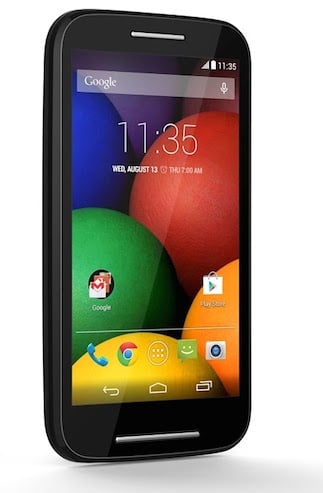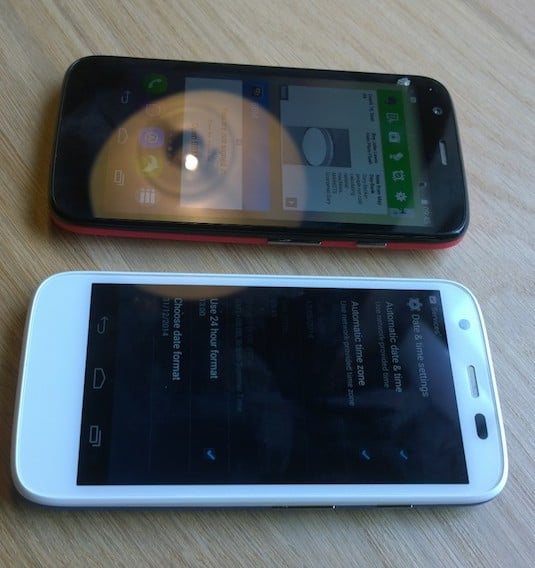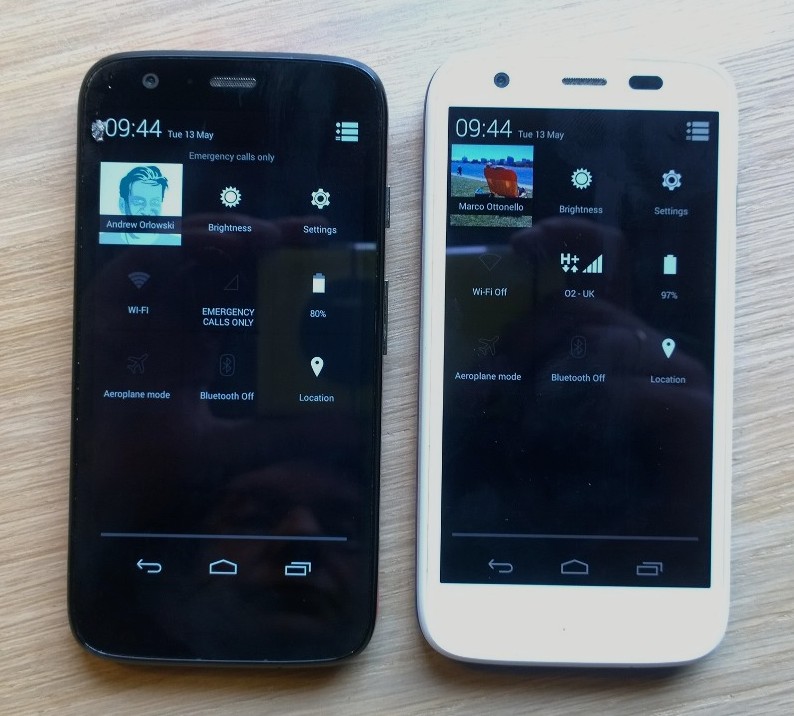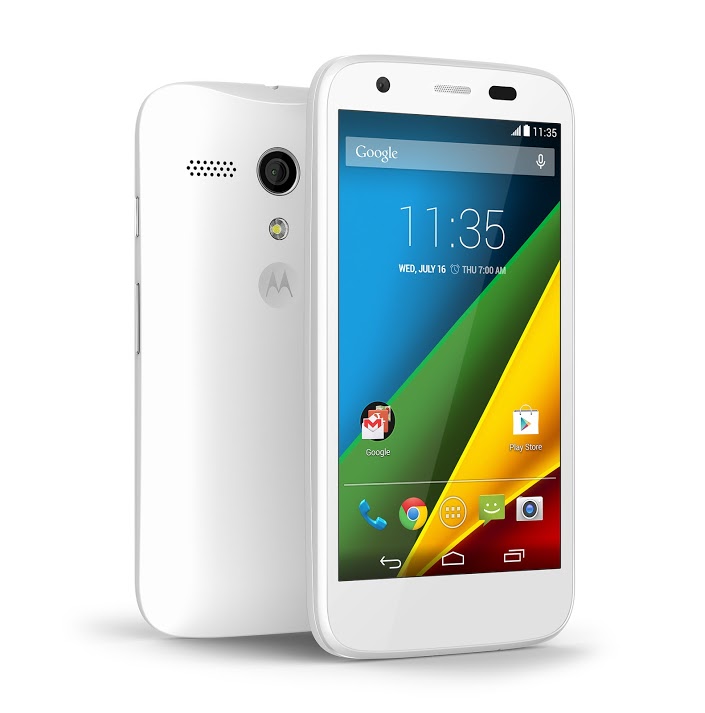Original URL: https://www.theregister.com/2014/05/13/moto_launches_89_droid_revs_g_with_lte/
Moto E pops up with £89 price tag – alongside new LTE Moto G cuz
Bang on the money
Posted in Personal Tech, 13th May 2014 17:55 GMT
Hands on Motorola has followed up its hit Moto G comeback smartphone with a 4G version, and an even cheaper variant, the 3G Moto E, both revealed today.

The new Moto E
We got a chance to have a brief play with the new pair.
Last year, Nokia became king of the budget smartphones with its Lumia 520 Windows Phone – but Motorola's new 3G Moto E will bring this under severe pressure.
E is for entry level
The Moto E is a super handset with a great choice of apps, including far better Google support, for considerably less dosh. At £89 ($149) the new E undercuts the £94.25 ($159) Lumia 520 by a whisker – in practice, they'll go head to head.
The budget Moto Android experience is much better than you could buy a year or two ago. Landfill Android this Moto E ain't. In short, the Google-owned biz has produced a phone that Nokia used to make a decade ago: a durable and comfortable good-value mid-ranger with decent features.

The Moto E side-view
The Moto E has the same comfortable body of the original Moto G launched last year; it's very similar in size at 124.8 x 64.8 x 12.3mm (4.91 x 2.55 x 0.48in), and you can grip it just as well. The Moto E loses the front-facing camera, but gains an MicroSD card slot.
You have to look hard to spot differences between the original G and the new E. All three models – the E, the original G, and the new G 4G/LTE – feature very similar styling: the E's 540-by-960-pixel display has an excellent density of 256ppi, and the 1,980mAh battery should comfortably see you through the day. The touchscreen is a tad sharper than the Lumia 630's 480-by-854 resolution, 218ppi density screen.
The E's 4.3in touchscreen means a swipe from the top – essential for Android – can just about be performed with the thumb, one-handed, by most users. Then again, I suspect many readers will install their own launcher, and most launchers allow you to flick down the Notifications panel without reaching for the top of the display.
The skimpy 4GB of internal storage in the E is complemented by a microSD slot that can take up to 32GB cards. That's a little disappointing, given the falling price of 64GB flash cards.
As with the original G, there's a variety of colours for the casing, and two types of Moto-branded cover: the standard removable cover, or a more grippy bumpy cover.
Visually, the main difference between the E and the original G is a chrome grill under the screen; the E uses Gorilla Glass 3, incidentally.
Moto hasn't skimped on the internals: in the E there's a dual-core 1.2GHz Qualcomm ARM Cortex-A7 Snapdragon processor and 1GB of RAM, but the result is snappy. It runs Android 4.4.2 (aka KitKat) with regular updates promised.
The absence of a heavy user-interface skin gives you zippy performance. Motorola Mobility – currently in the process of being sold by Google to Lenovo – says that compared to the more expensive Samsung Galaxy S4, the E answers calls 1.1 seconds quicker, launches the camera 1.7 seconds faster, returns you to your home screen faster by half a second, and launches the web browser almost a second faster.
So, what about the camera? Oh, best not to ask right now
Alas, the Moto E's 5Mp (2592x1944) camera performed abysmally in the low-light conditions chosen by Motorola to showcase the phone, in an obscure corner of Bermondsey, south London, today. We'll reserve judgment until we've given the cam a proper workout (in a few days) but, on this basis, low light use will probably involve gurning selfies as we squint at the screen.
The E will feature a few of Moto's own apps, but these are quite useful, and don't (unlike Samsung or Sony) muscle aside the stock apps. They include a rules-based personal assistant and, new here, an alert app that allows you to send emergency messages or allow a friend to find you. Moto makes its own camera and FM radio apps.
The Moto G 4G: This is a 4G bargain
Perhaps of more interest to slightly less skint punters is the Moto G 4G/LTE – the original Moto G could only support up to 3G. It shares the same pin-sharp display and battery (and alas the same iffy camera) as the original G. The family resemblance is so strong even experienced hacks were confused by the appearance of your reporter's original G alongside the newer models, and busied themselves taking snaps of my older phone.
The original Moto G was a deserved hit: it ran a barebones Android without the slowdown from the bloatware usually bundled by phone manufacturers.
It had a lot going for it: a dialer app that was quick to open, and good and loud alerts that were spot on. The result was a strong comeback from a company that had almost disappeared. The chief criticism of last year's G was lack of support for removable microSD cards – this has been rectified in the Moto G 4G.
The LTE-friendly G features a quad-core 1.2GHz Snapdragon ARM Cortex-A7 CPU from Qualcomm, 1GB of RAM, 8 or 16GB of storage, an excellent 4.5" display (720 x 1280 pixels), and a decent battery (a 2,070mAh part) – and it's in a very comfortable and sturdy little package measuring 129.9 x 65.9 x 11.6mm (5.11 x 2.59 x 0.46in).
At £149 the Android 4.4.2 Moto G 4G/LTE will compete head on with the comparably priced Nokia Lumia 625 and EE's own brand Kestrel, on sale at just £99 on pre-pay (with 10GB of monthly data thrown in).
But for this money, a Moto G 4G will get you a well-designed package, some quite useful Moto software, and (the company is keen to stress) regular platform bug-fixes and updates. It has the same range of cases as the Moto E plus a flip case that switches the display on and off.
To give it its full title, the "Moto G with LTE" is physically more or less the same as the original 3G G but 1g heavier, which is an achievement as it now packs an additional microSD slot and LTE antenna.
The G 4G features a sharp 326dpi display, and its 5Mp (2592x1944) camera is also identical to its 3G sibling. It's a little disappointing that the microSD card slot only accepts cards up to 32GB, as the new Lumia rival takes up to 128GB.

The original Moto G (top) and G with LTE (bottom) ... The G looks smaller, but that's because – like the cow, Father Dougal – it's further away.
Motorola's odd choice of launch venue also meant we couldn't test the LTE performance, even superficially. The best the O2 SIM could latch onto was 3G.
Where the "G with LTE" really scores today is with its compact, durable design. Nokia's Lumia 625 set the bar last autumn, priced at under £150 with EE pay-as-you-go, and that's now fallen to £99.99 from both EE and O2 in the UK. EE's own-brand Kestrel mobe can be had for £99, but it runs an older version of Android (JellyBean). It does however features a faster processor.
The new G can boast a much more pocketable package than the 625 – and, of course, a far greater choice of third-party apps from the Google Play Store. Forty quid more at EE will get you a Samsung Galaxy Ace with slower processor, lower resolution screen, and smaller battery.
While we haven't seen a UK operator's price tag for the new 4G G, the mobe promises to be a cracking deal. ®

